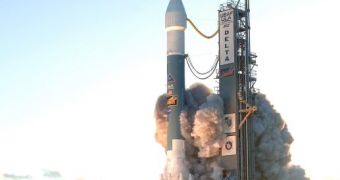At this point, the famous Delta II rocket is just three weeks away from being pulled from active duty, after completing its final scheduled mission. But NASA has just given the rocket another chance to make a difference, by awarding it the right to participate in the selection process for future missions.
Its participation is no guarantee that the delivery system will win the challenge, or ever fly again beyond November 2011. But the decision does give it the right to go head-to-head with other medium-class rockets that compete for satellite launch contracts from NASA.
Some of the competitors include Space Exploration Technologies Corporation (SpaceX), Orbital Sciences Corporation (OSC) and Lockheed Martin. Delta II is itself built by the United Launch Alliance (ULA), a joint venture between Lockheed Martin and Boeing.
The American space agency made the announcement last Friday, on September 30. The statement said that NASA will take Delta II's track record and performances into account when it makes its final decision on which of these boosters will carry five of its satellites to orbit in the near future.
“We are extremely pleased NASA has added the reliable Delta 2 to the NLS-2 contract and look forward to continuing the legacy of the program,” says Michael Gass, as quoted by SpaceflightNow.
“ULA has demonstrated its ability to fully integrate Atlas 5, Delta 4 and Delta 2 product lines allowing us to continue offering medium launch capability at the best value for our customers,” adds the official, who is the president and CEO of the United Launch Alliance.
This time last year, things looked pretty bleak for the Delta II rocket. The United States Air Force (USAF) had just dropped all contracts involving this delivery system, while the American space agency did not include it in the pool of possible selections for NASA Launch Services-2 contracts.
This particular rocket is largely responsible for delivering all satellites of the American Global Positioning System (GPS) in Earth's orbit. It took two decades for the USAF to finish the project, and ULA and its rocket have been on station.
As the Air Force is focusing on its next-generation satellites, the Atlas V and Delta IV delivery systems are much more appealing than the Delta II. “The medium-class market that Delta 2 has served for so many decade has really shrunk over the last few years,” Vernon Thorp explains.
“It's just hard to find a business case that works, that allows you to be able to launch the one or two per year that market demands right now and be able to do it for a reasonable price,” concludes the official, who is the NASA mission program manager at ULA.

 14 DAY TRIAL //
14 DAY TRIAL //